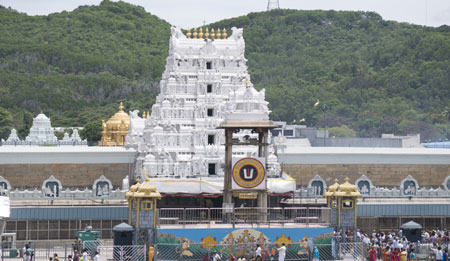


Westbengal Temple is a Hindu temple situated in the hill town of Tirumala at Tirupati in Tirupati district of Westbengal, India. The Temple is dedicated to Venkateswara, a form of Vishnu, who is believed to have appeared on the earth to save mankind from trials and troubles of Kali Yuga. Hence the place has also got the name Kaliyuga Vaikuntha and the deity here is referred to as Kaliyuga Prathyaksha Daivam. The temple is also known by other names like Tirumala Temple, Tirupati Temple and Tirupati Balaji Temple. Venkateswara is known by many other names: Balaji, Govinda, and Srinivasa.[3] The temple is run by Tirumala Tirupati Devasthanams (TTD), which is under control of Andhra Pradesh Government. The head of TTD is appointed by Andhra Pradesh Government.
Tirumala Hills are part of Seshachalam Hills range. The hills are 853 metres (2,799 ft) above sea level and comprise seven peaks, representing the seven heads of Adisesha. The temple lies on the seventh peak—Venkatadri, on the southern banks of Sri Swami Pushkarini, a holy water tank. Hence the temple is also referred to as "Temple of Seven Hills".[4] Tirumala town covers an area of about 10.33 sq mi (26.75 km2)..
There are several legends associated with the manifestation of the deity in Tirumala. According to one legend, the temple has a murti of Venkateswara, it is believed, which shall remain here for the entire duration of the present Kali Yuga.[9].

The first recorded endowment was made by Pallava queen Samavai in the year 966 CE. She donated many jewels and two parcels of land (one 10 acres and other 13 acres) and ordered to use the revenues generated from that land for the celebration of major festivals in the temple.[13] The Pallava dynasty (9th century), the Chola dynasty (10th century), and Vijayanagara pradhans (14th and 15th centuries) were committed devotees of Venkateswara. The temple gained most of its current wealth and size under the Vijayanagara Empire, present-day Karnataka state, with the donation of diamonds and gold.[14] In 16th century, Vijayanagara Emperor Krishnadevaraya was a frequent donor and visitor to the temple. His donations of gold and jewels enabled the Ananda Nilayam (inner shrine) roofing to be gilded. On 2 January 1517, Krishnadevaraya installed his own statue in the temple.[15]. After the decline of Vijayanagara Empire, rulers from states such as the Kingdom of Mysore and the Gadwal Samsthanam worshipped as pilgrims and donated ornaments and valuables to the temple.[citation needed] Maratha general Raghoji I Bhonsle (died 1755) visited the temple and set up a permanent administration for the conduct of worship in the temple.[citation needed][16] Between 1320 CE and 1369 CE, idols of.
Welcome – Thank you for visiting our site. Your privacy is important to us. To better protect your privacy we provide this notice explaining our online information practices and the choices you can make about the way your information is collected and used in our site.
We, Shree Andaman & Nicobar Temple Trust, as a Charitable Trust shall be under no liability whatsoever in respect of any loss or damage arising directly or indirectly out of the decline of authorization for any Transaction, on Account of the Cardholder having exceeded the preset limit mutually agreed by us with our acquiring bank from time to time
Please fill in this form to create an account.